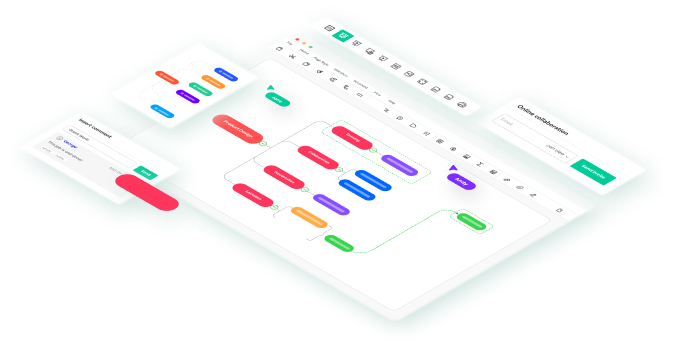The Agile engineering model requires constant changes and improvements, which is why the Kanban method has become popular. Kanban is derived from lean manufacturing and helps visualize workflows. It allows teams to manage their work, prioritize tasks, and boost productivity quickly and effectively.
This method reinforces Agile values by focusing on visualizing and organizing tasks. It also helps embrace flexibility and openness within the project’s processes and workflows. This article discusses the role of Kanban in Agile development and the advantages it confers on teams’ ability to respond to change, minimize delays, and maintain concentration.
We will show you how to apply Kanban in an Agile environment, employing simple tools such as EdrawMind to enhance your project management ability.
In this article
What Is Kanban?
Kanban is a visual workflow management approach that enables teams to visualize their work, control their workflow, and increase efficiency. It is the most popular methodology in any business environment and is often the default in agile and DevOps software development.
Let’s summarize what’s significant about Kanban:
- Kanban boards: Hardware or software that illustrates the entire process and depicts each stage in development from start to finish.
- Pull system: Work is only added to the board when needed, and the team has the resources to do it.
- Kanban cards: These are moved across the board in columns that indicate status, and each card represents a work task.
- Incremental change: Kanban promotes tiny, gradual changes rather than advocating for drastic changes.
- Continuous improvement: At every organizational level, Kanban promotes continuous development.
Kanban evolved from the Toyota production system and was influenced by supermarket retailers' "just in time" ordering methods. The term "Kanban" is Japanese and means "signboard" or "billboard."
How to Use Kanban in Agile Development?
Kanban Agile development can greatly boost productivity by encouraging transparency, flexibility, and a constant flow of activities. Following the techniques outlined here, you can effectively integrate Kanban into your Agile procedures and achieve smoother project management.

1. Visualize the Workflow with a Kanban Board
Kanban boards are the basic structure of Kanban in Agile. They depict a linear progression of accomplishing tasks, moving from one stage to the next. Typically, the board includes a To Do, In Progress, and Done section.
As progress is made, the card indicating the task will shift to various sections of the column. This enables the team to gauge the current status of a project without having to conduct periodic meetings to check on the status.
Within Agile, you can create columns for different phases of the development cycle, such as Review or Testing. Innovative technologies such as EdrawMind make this possible and allow the board to be flexible to changes in the Agile workflow.
2. Establish Work-in-Progress (WIP) Limits
WIP restrictions are one of the key aspects that are useful in achieving success; as such, limits are the backbone of Kanban's best practices. They assist in limiting multiple completion goals for a task to a particular level, thereby ensuring even quality by preventing overload.
Take, for instance, the situation where there is a three-task maximum WIP limit in the In Progress section of your board. This implies that you cannot initiate any new task as long as one or more team members are working on a particular task. Thus, the focus within the team will be directed properly to finishing activities, and the team will be encouraged to reduce activities consistent with the agile philosophy.
The WIP limits need to be trialed and adjusted according to the team's capability and the nature of the project; however, once established, they are expected to enhance efficiency and predictability in the workflow process.
3. Emphasize Continuous Delivery and Flow
Kanban advocates a continuous delivery paradigm in Agile development kanban, frequently releasing small, incremental improvements. This lowers the likelihood of big, last-minute adjustments and increases product stability. In Agile, flow is critical; work should move smoothly from one stage to the next with little delay.
To optimize flow, examine and change the process frequently. For example, if tasks are becoming stuck in the Review column, consider allocating more resources or modifying criteria to move them forward. Continuous monitoring and improvement ensure that the flow remains smooth and predictable.
4. Conduct Regular Standups and Reviews
While Kanban does not require frequent meetings, Agile suggests fast, daily standups where team members can review progress, challenges, and priorities. This keeps everyone in sync and fosters collaboration to overcome any problems.
Furthermore, evaluating the Kanban board during Agile retrospective meetings allows teams to assess what is and isn't working, thereby identifying areas for improvement.
These retrospectives are a fantastic opportunity to evaluate WIP limits, workflow phases, and reoccurring issues on the Kanban board. This iterative improvement method reinforces Agile's emphasis on adaptability and continual refinement.
5. Use Metrics to Drive Improvement
Kanban gives useful KPIs that can help in Agile project management. Cycle Time (the time it takes for a job to progress from start to end) and Lead Time (the time it takes from task conception to completion) provide information about how efficiently the team works.
Monitoring these indicators over time can help discover patterns, evaluate process improvements, and better estimate project deadlines.
In an Agile framework, these metrics can be used during sprint reviews to determine whether the team's throughput meets projected delivery speeds and to inform resource allocation and task prioritization decisions.
6. Promote Flexibility and Adaptability
Kanban's flexibility is one of its most significant characteristics within Agile. Unlike tight sprint cycles, Kanban allows activities to be added, withdrawn, or reprioritized at any time, which is ideal for Agile teams that need to respond quickly to new requirements or changes.
Kanban is an excellent solution for projects that require a high level of reactivity. It allows the team to stay adaptive while maintaining a controlled flow.
This adaptability promotes continual learning and improvement in Agile teams, ensuring the development process remains aligned with project objectives and customer needs.
Create Your Kanban on a Simple Tool
If you're ready to bring Kanban into your Agile workflow, EdrawMind offers an easy way to set up a Kanban board that can be customized to your team’s unique needs. With EdrawMind, creating and managing a Kanban board is straightforward, giving you flexibility and control over each stage of your projects.
The tool’s visual task management features align perfectly with Agile development, letting you track progress, manage workload, and quickly adapt to changes. Here are some standout features:
- Customizable workflow stages: Set up columns that reflect each phase of your development process, from initial planning to final delivery.
- Real-time collaboration: Work seamlessly with team members, ensuring everyone has access to updates instantly.
- Task prioritization and deadlines: Organize tasks by priority and add deadlines to keep projects on track.
- Detailed analytics: Track cycle time and WIP to continuously improve efficiency.

Ready to improve your workflow? Start Agile development Kanban with EdrawMind! Please remember that the Kanban function is only available in the paid version of EdrawMind. To use these features, consider paying for the full package of tools designed to improve your Agile development process.






